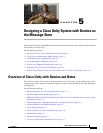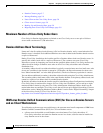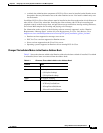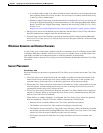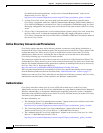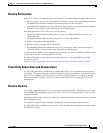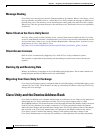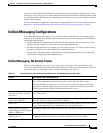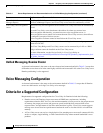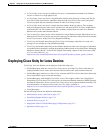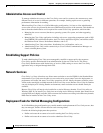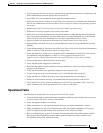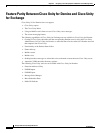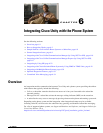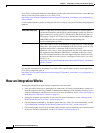
5-9
Design Guide for Cisco Unity Release 5.x
OL-14619-01
Chapter 5 Designing a Cisco Unity System with Domino as the Message Store
Unified Messaging Configurations
Cisco Unity requires Editor with Delete Documents permission for the address book that Cisco Unity
monitors. A Cisco
Unity server can monitor the address books for one domain, including Names.nsf and
any secondary address book that may be supporting proxy/remote users (users who do not have mail files
in the Domino domain).
For more information on permission requirements, see the applicable Cisco Unity installation guide at
http://www.cisco.com/en/US/products/sw/voicesw/ps2237/prod_installation_guides_list.html.
Unified Messaging Configurations
In a Unified Messaging configuration, Cisco Unity does not own the directory or messaging data but
instead uses existing directory (Domino address book) and message store information. The benefits of
Unified Messaging include:
• Significantly reduced administrative overhead because the customer does not need to create and
maintain separate accounts for e-mail and voice messaging applications.
• No dedicated infrastructure for a separate voice-messaging system. Cisco Unity uses the existing
messaging infrastructure by voice-enabling the e-mail environment.
• Starting with Unified Messaging is administratively easier than starting with a Voice Messaging
system and later migrating to Unified Messaging.
Unified Messaging, No Domino Cluster
When you are setting up two or more Cisco Unity servers, the servers can be networked by using
Cisco
Unity Digital Networking. If the phone system has ports available, you can hook up more than one
Cisco
Unity server to each phone system. For more information, see Table 5-3.
Table 5-3 Server Requirements and Recommendations for a Unified Messaging Configuration
Servers Requirements and Recommendations
Cisco Unity server Each physical site that includes one or more Domino servers on which mailboxes for
Cisco
Unity subscribers are homed also includes at least one Cisco Unity server.
Each Domino domain requires a Cisco Unity server. If you need to import Cisco Unity
subscribers in different Domino domains, you must install a Cisco
Unity server in each
Domino domain and use Digital Networking between the servers.
Domino address book server,
message store server, and mail
drop server
Domino servers must be in the same highly available and connected LAN as the
Cisco
Unity server.
Domain controller/global
catalog server (DC/GC)
There must be at least one DC/GC per physical site that includes a Cisco Unity server. If
necessary, the Cisco
Unity server can be the DC/GC.
DNS server There must be at least one DNS server per physical site that includes a Cisco Unity server.
In sites with enough servers, we recommend two or more DNS servers.
Media gateways (for phone
system integrations that include
PIMG or TIMG units
The PIMG or TIMG units can be connected to the Cisco Unity server by a LAN or a WAN.
Cisco Unified Communications
Manager servers
The Cisco Unified Communications Manager (CM) (formerly known as Cisco Unified
CallManager) and Cisco
Unity servers can be connected by a LAN or a WAN.



